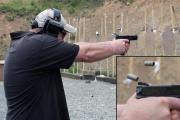It really does depend. 1 on your skill, 2. what the target is doing. Is it a hostage shot or is he wearing body armor and your first rounds had no effect. On the range I can make head shots out to 25 yards with ease however in real life I would not want to take one past 10 yards cut that in half if it was a hostage situation. .
Pat




 Reply With Quote
Reply With Quote


 . Snarky and easily butt hurt. Favorite animal is the Cape Buffalo....likely indicative of a personality disorder.
. Snarky and easily butt hurt. Favorite animal is the Cape Buffalo....likely indicative of a personality disorder.

